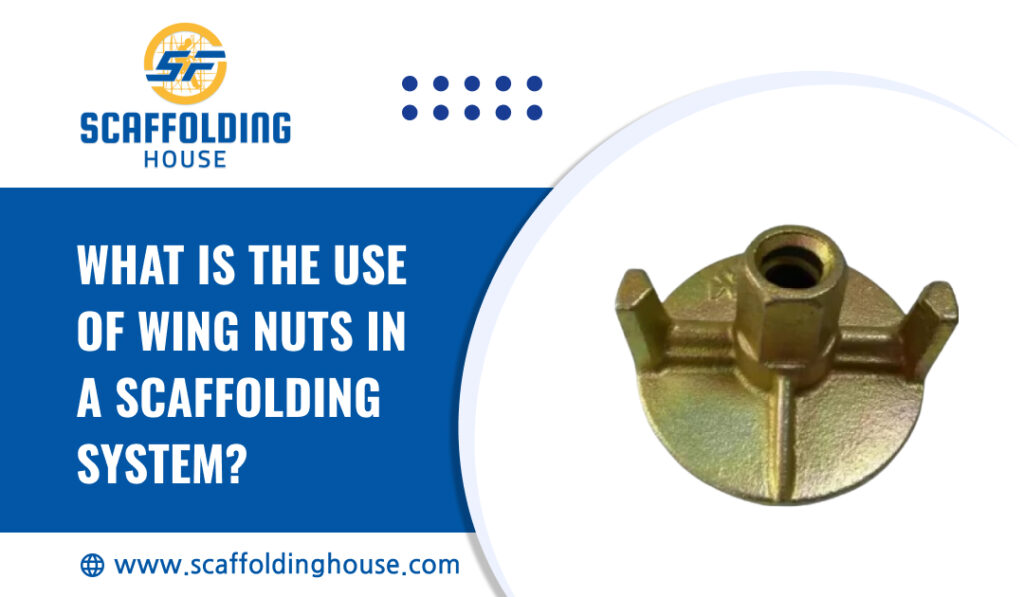In the context of scaffolding, a wing nut is a specialized nut commonly used in the construction industry to secure and adjust scaffolding components. Its unique wing design allows for easy hand tightening and loosening, making it a practical option for scaffolding applications.
What is the purpose of scaffolding wing nut?
The purpose of a scaffolding wing nut is to securely fasten and adjust scaffolding components quickly and efficiently. Its wing-shaped extensions allow for easy hand tightening and loosening, eliminating the need for tools. This makes it particularly useful for assembling, disassembling, and adjusting scaffolding on construction sites. Here’s a breakdown of a typical wing nut used in scaffolding:
Design and Features:
- Wing-shaped Extensions: The most notable feature of a wing nut is the pair of wing-shaped extensions on each side. These wings provide a comfortable grip for hand tightening or loosening, eliminating the need for tools.
- Threaded Interior: The central hole of the wing nut is internally threaded, enabling it to be attached to threaded rods, scaffolding bolts, or other components.
- Durable Material: Wing nuts used in scaffolding are typically made from strong materials, ensuring they can handle the load-bearing requirements and harsh outdoor conditions of construction sites. Scaffolding House is among the top scaffolding manufacturers and ensures to provide high-quality wing nuts.
Common Uses:
- Height Adjustment: Wing nuts are used for adjusting the height of scaffolding components, such as scaffold tubes or props, by attaching threaded rods that can be extended or retracted.
- Connection and Coupling: They play a vital role in connecting horizontal and vertical scaffolding elements, ensuring a stable, secure connection.
- Formwork Support: Wing nuts help secure formwork and shoring systems, keeping formwork panels in place and providing a stable base for concrete pouring.
Safety and Efficiency:
- Wing nuts enhance both safety and efficiency during scaffolding assembly and disassembly by allowing quick, tool-free adjustments. For a scaffolding supplier in Dubai, consider contacting Scaffolding House.
- Reusable: Many wing nuts are designed for reuse, making them cost-effective for projects that require multiple scaffolding setups.
The choice of materials and sizes may vary depending on the manufacturer and regional standards. Ensuring safety is crucial when working with scaffolding, so it’s important to follow industry guidelines for proper installation and use of wing nuts to guarantee the safety of workers and maintain the structural integrity of the scaffolding system.
How do you use scaffolding wing nut?
Wing nuts are commonly used in construction and carpentry to fasten temporary structures, such as scaffolding, or to attach components that need regular adjustments. Using a wing nut for scaffolding is a quick and efficient way to secure components. Here’s a simple guide on how to properly use a wing nut to ensure a tight, secure fit:
- Slide onto the threaded rod: Position the wing nut onto the threaded end of the scaffolding component, such as a tie rod or brace.
- Turn clockwise to tighten: Hold the wings and rotate the wing nut clockwise to tighten it onto the component.
- Ensure a secure fit: Tighten the nut until it’s snug, but avoid overtightening.
What is the difference between anchor nut and wing nut?
While anchor nuts and wing nuts both are used in construction work, an anchor nut is a specialized wing nut used in concrete formwork to offer a secure connection point for tie rods, while a wing nut comes with wings on either side that make it easy to tighten and loosen it. Anchor nuts are typically used for applications where a wider surface area is required for secure fastening.
- A wing nut consists of smaller wings, while an anchor nut possesses a larger, flat plate-like base to offer a secure connection.
- Wing nuts are commonly used for assembly and disassembly in several applications. On the other hand, anchor nuts are used in concrete formwork to attach tie rods. They offer a more secure fastening, making it ideal for high-stress applications.
Conclusion
Wing nut comes with several features and applications, making it appropriate for scaffolding work. If you are in the construction field, you would find wing nuts essential and indispensable equipment. For any kind of scaffolding and formwork accessories, you can contact Scaffolding House.

